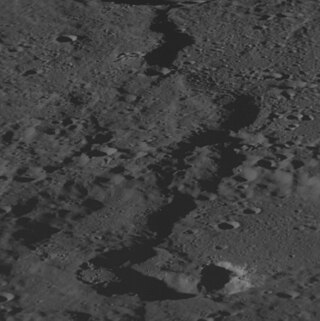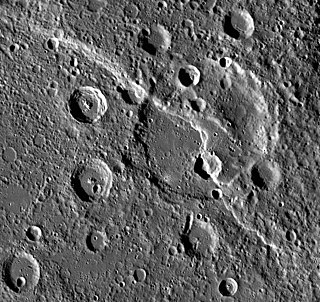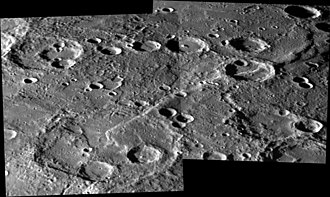
An escarpment is a steep slope or long cliff that forms as a result of faulting or erosion and separates two relatively level areas having different elevations.

Discovery Rupes is an escarpment on Mercury approximately 650 kilometers (400 mi) long and 2 kilometres (6,562 ft) high, located at latitude 56.3 S and longitude 38.3 W. It was formed by a thrust fault, thought to have occurred due to the shrinkage of the planet's core as it cooled over time. The scarp cuts through Rameau crater. It was discovered by Mariner 10.
Rupes is the Latin word for 'cliff'. It is used in planetary geology to refer to escarpments on other worlds. As of January 2013, the IAU has named 62 such features in the Solar System, on Mercury (17), Venus (7), the Moon (8), Mars (23), the asteroids Vesta (2) and Lutetia (2), and Uranus's satellites Miranda (2) and Titania (1).

Victoria Rupes is an escarpment in the Victoria quadrangle of Mercury. The quadrangle was named after this escarpment, and the escarpment itself was named after the Victoria, a ship used on the famous expedition of Ferdinand Magellan. Its name was adopted by the International Astronomical Union (IAU) in 1976.

Santa María Rupes is a prominent lobate escarpment and fault line on Mercury. According to data from Aricebo, it has a relief of roughly 700m. The formation was named after the ship Santa María, used by Christopher Columbus. The escarpment was probably created as Mercury cooled and thus contracted.

Beagle Rupes is an escarpment on Mercury, one of the highest and longest yet seen. It was discovered in 2008 when MESSENGER made its first flyby of the planet. It has an arcuate shape and is about 600 kilometres (370 mi) long. The scarp is a surface manifestation of a thrust fault, which formed when the planet contracted as its interior cooled.

Claritas Rupes is a scarp in the Phoenicis Lacus quadrangle of Mars, located at 26° South and 105.4° West. It is 924 km long and was named after an albedo feature at 25S, 110W. The term "Rupes" is used in planetary geology to refer to an escarpments or cliff on Mars and other planets. It is the Latin word for cliff.

Adventure Rupes is an escarpment on Mercury approximately 270 kilometres long located in the southern hemisphere of Mercury. Discovered by the Mariner 10 spacecraft in 1974, it was formed by a thrust fault, thought to have occurred due to the shrinkage of the planet's core as it cooled over time.

Resolution Rupes is an escarpment on Mercury approximately 190 kilometers long located in the southern hemisphere of Mercury. Discovered by the Mariner 10 spacecraft in 1974, it was formed by a thrust fault, thought to have occurred due to the shrinkage of the planet's core as it cooled over time.

Hero Rupes is an escarpment on Mercury more than 300 kilometres long located in the southern hemisphere of Mercury. Discovered by the Mariner 10 spacecraft in 1974, it was formed by a thrust fault, thought to have occurred due to the shrinkage of the planet's core as it cooled over time.

Belgica was a barque-rigged steamship that was built in 1884 by Christian Brinch Jørgensen at Svelvik, Norway as the whaler Patria. In 1896, she was purchased by Adrien de Gerlache for conversion to a research ship, taking part in the Belgian Antarctic Expedition of 1897–1901, becoming the first ship to overwinter in the Antarctic. In 1902, she was sold to Philippe, Duke of Orléans and used on expeditions to the Arctic in 1905 and from 1907 to 1909.

Leopardi is a crater on Mercury. Its name was adopted by the International Astronomical Union in 1976. Leopardi is named for the Italian writer Giacomo Leopardi, who lived from 1798 to 1837.

Enterprise Rupes is an escarpment on Mercury, located at 36.54°S, 283.46°W. It is the longest rupes on Mercury, with a length of 820 kilometers (510 mi). The escarpment was named after USS Enterprise, a ship which conducted the first surveys of the Mississippi and Amazon rivers.

Discovery Rupes is an escarpment on Mercury, approximately 267 kilometers (166 mi) long, located at latitude 58.52 N and longitude 53.25 W. It was formed by a thrust fault, thought to have occurred due to the shrinkage of the planet's core as it cooled over time. The scarp cuts through Duccio crater.

Vostok Rupes is an escarpment on Mercury. The scarp is a surface manifestation of a thrust fault, which formed when the planet contracted as its interior cooled.

Carleton is a crater on Mercury. Its name was adopted by the International Astronomical Union (IAU) on October 19, 2018. Carleton is named for the Irish writer William Carleton.
The Rupes Mercator is an escarpment located on the Moon. It is named after the neighboring Mercator crater, a name assigned to it in 1935 by the International Astronomical Union in honor of the Flemish geographer and mathematician Gérard Mercator.















